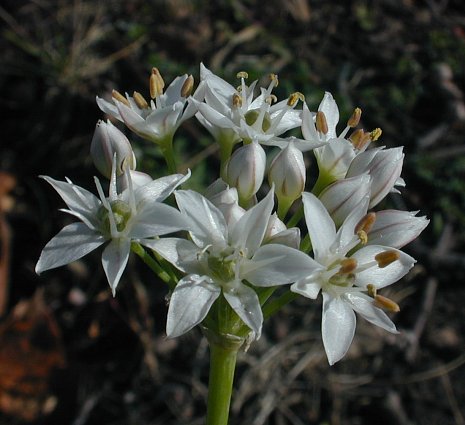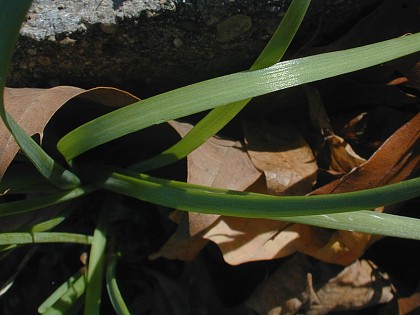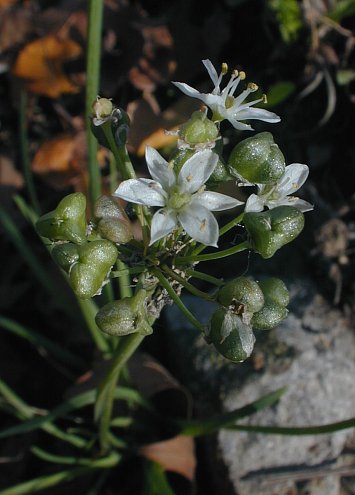Description: This herbaceous perennial plant consists of a rosette of 2-8 basal leaves and a single flowering stalk. The glabrous basal leaves are up to 12" long and ¼" across; they are linear with parallel veins, flattened and solid in cross-section, rather than round and hollow. The basal leaves are rather floppy and often curve downward near the middle, rather than remaining erect. They are green or greyish green, but turn yellow and wither away after the flowers bloom. The flowering stalk is up to 18" long and stiffly erect; it is round or terete and solid in cross-section. This stalk is devoid of cauline leaves and terminates in an umbel of 15-40 flowers that spans about 2" across. Each flower is about ¼" across and consists of 6 white tepals, 6 stamens with conspicuous anthers, and a single slender style. Each tepal may have a line along the middle of its outer/lower surface that is light green, light purple, or light brown. The white filaments of the stamens are narrowly triangular as they become more narrow at their tips where the anthers occur. Each flower has a slender pedicel up to 1" long. At the base of the umbel, there are often 1-3 membranous bracts that originally enclosed the buds of the flowers.

The blooming
period occurs from late summer to early fall and lasts about 1 month.
The flowers are fragrant. Each flower is replaced by a green seed
capsule that is 3-celled and has 3 rounded lobes. Each capsule contains
several seeds that are small, black, and shiny. Unlike some Allium
spp., no aerial bulbets are produced. The root system
consists of an elongated bulb with fibrous roots at the bottom. This
plant reproduces by its seeds and vegetative offsets. It often forms
clumps of plants.
Cultivation:
The preference is full or partial sun, moist to dry conditions, and a
rich loamy soil. This plant can spread aggressively by either its seeds
or vegetative offsets. Clumps of plants are easily divided and the
divided clumps can be planted in new locations. This plant is winter
hardy in all areas of Illinois.

Range &
Habitat:
According to official records, Garlic Chives has not naturalized in
Illinois, even though it is often cultivated as a garden plant. This is
surprising, considering its aggressive nature. However, the webmaster
has observed clumps of naturalized plants that were growing in 3
different locations in the Champaign-Urbana area in Champaign County,
Illinois (see Distribution
Map). Garlic Chives has naturalized in parts of Wisconsin,
Iowa, and Nebraska, and it seems likely that this plant has naturalized
in other counties of Illinois as well. It is native to China and parts
of SE Asia. So far, habitats in Illinois include a degraded meadow in a
wooded area, the bank of a drainage ditch, and the edge of a yard along
a sidewalk. Several clumps of Garlic Chives have persisted in the
meadow for several years.
Faunal Associations:
The nectar of the flowers attracts bees, wasps, flies, butterflies, and
skippers. Some of the bees probably collect pollen as well. The foliage
has a garlic scent, which is repugnant to many mammalian herbivores.
However, young leaves are edible to humans in limited amounts.

Photographic
Location:
Along a sidewalk in Urbana, Illinois.
Comments:
Garlic Chives is often grown in gardens because of its attractive
flowers and the culinary properties of the leaves. This plant is fairly
easy to identify because it blooms later than other native or
naturalized Allium spp., usually in late summer or
early fall. The basal leaves of Garlic Chives resemble those of the
native Allium cernuum (Nodding Onion), but the
latter species has umbels that hang downward and it blooms during
mid-summer. The flowering umbels of Garlic Chives resemble those of the
native Allium stellatum (Cliff Onion), but the
latter has basal leaves that are more narrow and upright. Other Allium
spp. differ from Garlic Chives because they bloom earlier in
the year, or they produce aerial bulbets, or they have basal leaves
that are round and hollow in cross-section.